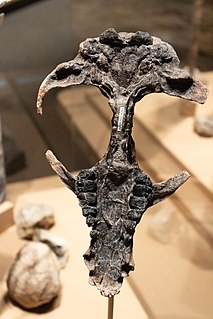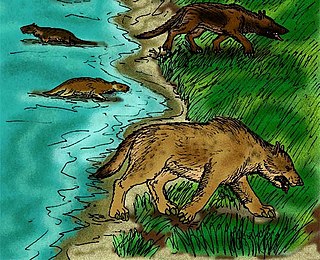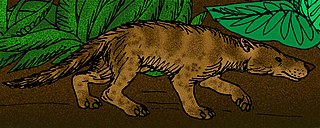 W
WMesonychia is an extinct taxon of small to large-sized carnivorous ungulates related to the cetartiodactyls. Mesonychids first appeared in the early Paleocene, went into a sharp decline at the end of the Eocene, and died out entirely when the last genus, Mongolestes, became extinct in the early Oligocene. In Asia, the record of their history suggests they grew gradually larger and more predatory over time, then shifted to scavenging and bone-crushing lifestyles before the group became extinct.
 W
WMesonychidae is an extinct family of small to large-sized omnivorous-carnivorous mammals. They were endemic to North America and Eurasia during the Early Paleocene to the Early Oligocene, and were the earliest group of large carnivorous mammals in Asia. They are not closely related to any living mammals. Mesonychid taxonomy has long been disputed and they have captured popular imagination as "wolves on hooves," animals that combine features of both ungulates and carnivores. Skulls and teeth have similar features to early whales, and the family was long thought to be the ancestors of cetaceans. Recent fossil discoveries have overturned this idea; the consensus is that whales are highly derived artiodactyls. Some researchers now consider the family a sister group either to whales or to artiodactyls, close relatives rather than direct ancestors. Other studies define Mesonychia as basal to all ungulates, occupying a position between Perissodactyla and Ferae. In this case, the resemblances to early whales would be due to convergent evolution among ungulate-like herbivores that developed adaptations related to hunting or eating meat.
 W
WAnkalagon saurognathus is an extinct carnivorous mammal of the family Mesonychidae, endemic to North America during the Paleocene epoch, existing for approximately 3.1 million years .
 W
WDissacus is a genus of extinct carnivorous jackal to coyote-sized mammals within the family Mesonychidae, an early group of hoofed mammals that evolved into hunters and omnivores. Their fossils are found in Paleocene to Early Eocene aged strata in France, Asia and southwest North America, from 66–50.3 mya, existing for approximately 15.7 million years .
 W
WEoconodon is an extinct genus of triisodontid mesonychid that existed during the early Paleocene of North America. Characteristics of the genus include massive jaws, blunt builds, and strong canine teeth.
 W
WHapalodectes is an extinct genus of otter-like mesonychids from the Late Paleocene to Early Eocene, some 55 million years ago. Although the first fossils were found in the Eocene strata of Wyoming, the genus originated in Mongolia, as the oldest species is H. dux, which was found in Late Paleocene strata in the Naran Bulak Formation.
 W
WHapalodectidae is an extinct family of relatively small-bodied mesonychian placental mammals from the Paleocene and Eocene of North America and Asia. Hapalodectids differ from the larger and better-known mesonychids by having teeth specialized for cutting, while the teeth of other mesonychids, such as Mesonyx or Sinonyx, are more specialized for crushing bones. Hapalodectids were once considered a subfamily of the Mesonychidae, but the discovery of a skull of Hapalodectes hetangensis showed additional differences justifying placement in a distinct family. In particular, H. hetangensis has a postorbital bar closing the back of the orbit, a feature lacking in mesonychids. The skeleton of hapalodectids is poorly known, and of the postcranial elements, only the humerus has been described. The morphology of this bone indicates less specialization for terrestrial locomotion than in mesonychids.
 W
WHarpagolestes is an extinct genus of hyena like, bear sized mesonychid mesonychian that lived in Central and Eastern Asia and western and central North America during the middle to late Eocene.
 W
WHonanodon is an extinct genus of hapalodectid mesonychian found Middle to Late Eocene strata of China and Pakistan.
 W
WJiangxia chaotoensis is a Chinese mesonychid from the Nongshanian division of the Upper Paleocene. It may be related to the genera Dissacus and Hukoutherium.
 W
WLohoodon is a genus of hapalodectid mesonychians which lived during the middle Eocene. Fossils of Lohoodon are found in middle Eocene-aged strata of China and Pakistan.
 W
WMesonyx is a genus of extinct mesonychid mesonychian mammal: fossils of the various species are found in Early to Late Eocene-age strata in the United States and Early Eocene-aged strata in China, 51.8—51.7 Ma (AEO).
 W
WMongolestes is an extinct genus of mesonychid known from the 'Ulan Gochu' formation of Inner Mongolia, and likely originated in Asia. It was the last surviving representative of Mesonychia and became extinct in the early Oligocene.
 W
WPachyaena was a genus of heavily built, relatively short-legged mesonychids, early Cenozoic mammals that evolved before the origin of either modern hoofed animals or carnivores, and combined characters similar to both. The genus likely originated from Asia and spread to Europe, and from there to North America across a land bridge in what is now the North Atlantic ocean. Various described species of Pachyaena ranged in size from a coyote to a bear. However, recent work indicates that Pachyaena is paraphyletic, with P. ossifraga being closer to Synoplotherium, Harpagolestes and Mesonyx than to P. gigantea.
 W
WSinonyx is a genus of extinct, superficially wolf-like mesonychid mammals from the late Paleocene of China. It is within the family Mesonychidae, and cladistic analysis of a skull of Sinonyx jiashanensis identifies its closest relative as Ankalagon. S. jiashanensis was discovered in Anhui province, China, in the Tuijinshan formation.
 W
WSynoplotherium is an extinct genus of relatively small, wolf-like mesonychids that lived 50 million years ago, in what is now Wyoming.
 W
WTriisodon is a genus of extinct mesonychian mammal that existed during the Early Paleocene of New Mexico, North America. The genus was named by Edward Drinker Cope in 1881 as a member of the Acreodi, a now invalid taxon that encompassed both creodonts and mesonychians. The premolar teeth have three points, hence the generic name. Cope described the type specimen of T. quivirensis as "about the size of a wolf." A smaller species has also been identified from the same region. Since material from this genus is incomplete, the exact size of adults and whether they showed sexual dimorphism or regional variations in size is unknown.
 W
WTriisodontidae is an extinct, probably paraphyletic, or possibly invalid family of mesonychian placental mammals. Most triisodontid genera lived during the Paleocene in North America, but the genus Andrewsarchus is known from the middle Eocene of Asia. Triisodontids were the first relatively large predatory mammals to appear in North America following the extinction of the dinosaurs. They differ from other mesonychian families in having less highly modified teeth.
 W
WYantanglestes is a genus of small, Chinese mesonychid with slender jaws that first appeared during the Early Paleocene in the Thanetian stage. It was found throughout Asia. It is the oldest known mesonychid. Yantanglestes became extinct during the Nongshanian division of the Late Paleocene, and lived sympatrically with its descendant genera, including Dissacus, Sinonyx and Jiangxia.